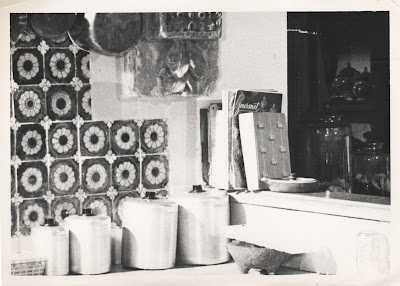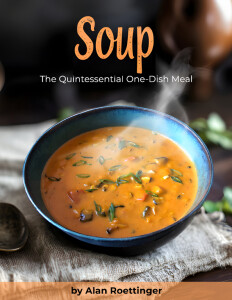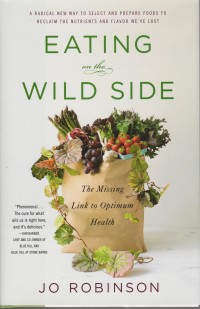1) I know what goes on in the back room at even the finest restaurants (you don’t wanna know, believe me). I also know how vile the product (I won’t say food) is at fast fare outlets (I won’t say restaurants). More importantly, I know that the only way to break free from an over-reliance on unhealthy options is to prepare food at home, using primarily fresh, whole, preferably organic ingredients. The importance of this cannot be overstated.
2) There is a distinct pleasure, different from all others and irreplaceable, that comes from making our own food. It is a primary connection we have with one of the essentials of our survival, which cannot be abridged or imitated. It’s an essential art that everyone can practice and take part in, young or old, regardless of their skill level.
 After my father died, almost ten years ago, I was selecting some of his photos to keep. He was an ardent, excellent photographer, and there were thousands of images to sort through. I came across a detail shot he took in the kitchen of our first home in Mexico. There were no others of that kitchen, so I kept it, even though it was a bit faded and it didn’t show much (or so I thought at the time).
After my father died, almost ten years ago, I was selecting some of his photos to keep. He was an ardent, excellent photographer, and there were thousands of images to sort through. I came across a detail shot he took in the kitchen of our first home in Mexico. There were no others of that kitchen, so I kept it, even though it was a bit faded and it didn’t show much (or so I thought at the time).
A few nights ago, I came across this picture and began poring over the details. At the upper left corner, hang a set of pots (this would be just to the right of the stove). These were the original “Revereware” pots, with thick copper-clad bottoms–not the flimsy ones they sell now, with barely a micron of copper on their skinny butts. On the wall are hand-painted ceramic tiles, each one wildly different from every other, and one of a pair of hand-carved stone pieces salvaged from a demolished hacienda–a decorative support for the extractor-fan hood (hand-made from wood beams, brick and mortar). On the ledge are “The Joy of Cooking,” a couple of issues of “Gourmet Magazine,” a well-worn copy of “Mastering the Art of French Cooking,” and a Mexico City edition of the “Junior League Cookbook.” In the window (a little dark to see) two large locally crafted glass jars contain home-made cookies. On the counter, four canisters hold the essential staples, flour, sugar, coffee, and salt. For some reason, a plastic ice tray sits atop a molcajete, the three-legged volcanic stone mortar ubiquitous in Mexican kitchens.
The significance of this picture for me is profound. For one, it was the first kitchen I ever cooked in. It was right there that I first learned to heat a tortilla over an open flame, flipping it bare-handed until it was slightly charred. I must have been about seven or eight years old at the time. Over the years, I went on to learn many other things from the maids, both Mexican dishes and the American stuff my mother had taught them to make. My parents wouldn’t eat Mexican food, so after lunch, I would sneak into the kitchen to have a second meal with “the help.” This gave me an opportunity not only to eat some seriously exciting food, but to watch it being made, see the individual steps, and inhale the exotic aromas.
I can still feel the warmth, the wood-and-woven-straw kitchen chairs, the uneven tiles on the walls; I can smell the fresh-made tortillas, fire-roasted chiles and bubbling sauces; I can hear the commotion, the unique sounds of that kitchen–the molcajete being used to grind tomatoes, onions, garlic, and chiles into a puré, and the “choom!” sound as the puré was added to a hot pan; I can taste the sopa de fideo, chilaquiles, chiles rellenos, and many other fabulous dishes, conjured from the ancestral body of knowledge our maids brought with them into our home and into my life. Whatever I cook today was born here.
The other significance of the picture is the very heart of the message I began with, which is that the closer to “hand-made” we live our lives, the richer our experience of living is, and the more indelible our fond memories will inevitably be. Truly, there will never be a more fulfilling meal than one cooked at home, by someone we know–someone who has our health and pleasure in mind, and genuinely hopes we enjoy it.
In Mexico they wish you “Buen provecho!” when you sit down to eat. Unlike the French “Bon Appétit!” which wishes you a good appetite for the meal, this saying expresses the hope that you’ll enjoy a “good benefit” from eating it. Both sayings come from a tradition as old as civilized human beings–one I hope to keep alive, add my creativity and love to, and help others to participate in with gusto: the home-cooked meal.







cool.
This view of your first kitchen is very appetizing! Thank you for being so generous to share! 🙂
The only thing I dislike about traveling for more than a day or two is having to eat restaurant food day in and day out. I miss my own cooking and the fresh foods I buy every afternoon that go into it. When travel gets to two weeks or more (in one place), I seek to rent an apartment, so we can have a kitchen and I can cook fresh, well-balanced meals. I’m with you, Alan!
Cheers,
Andy
Alan,
Thanks for posting this wonderful reminder of a Mexican cocina. I have such fond memories of humble Mexican foods that arrived on my plate, like fresh tortillas cradling homegrown avocados, salt and salsa for a snack. Or posole cooked on a corncob fire in an outdoor kitchen in a country village. Mmmmm!